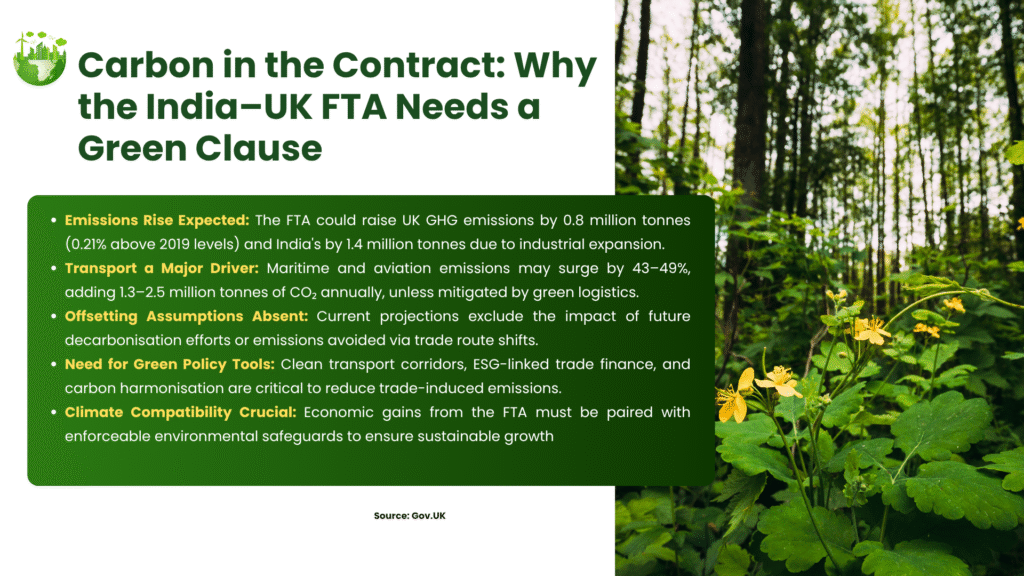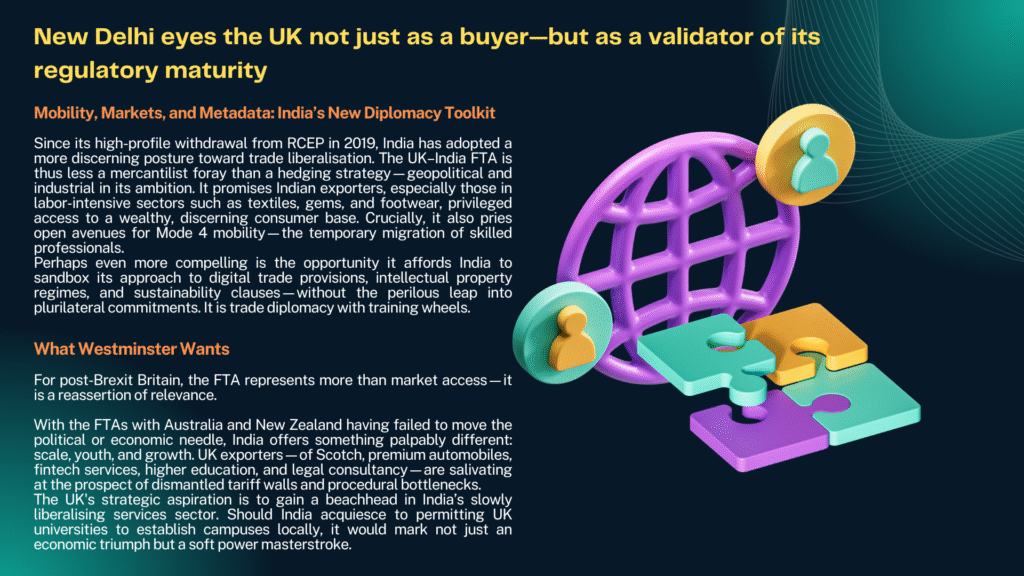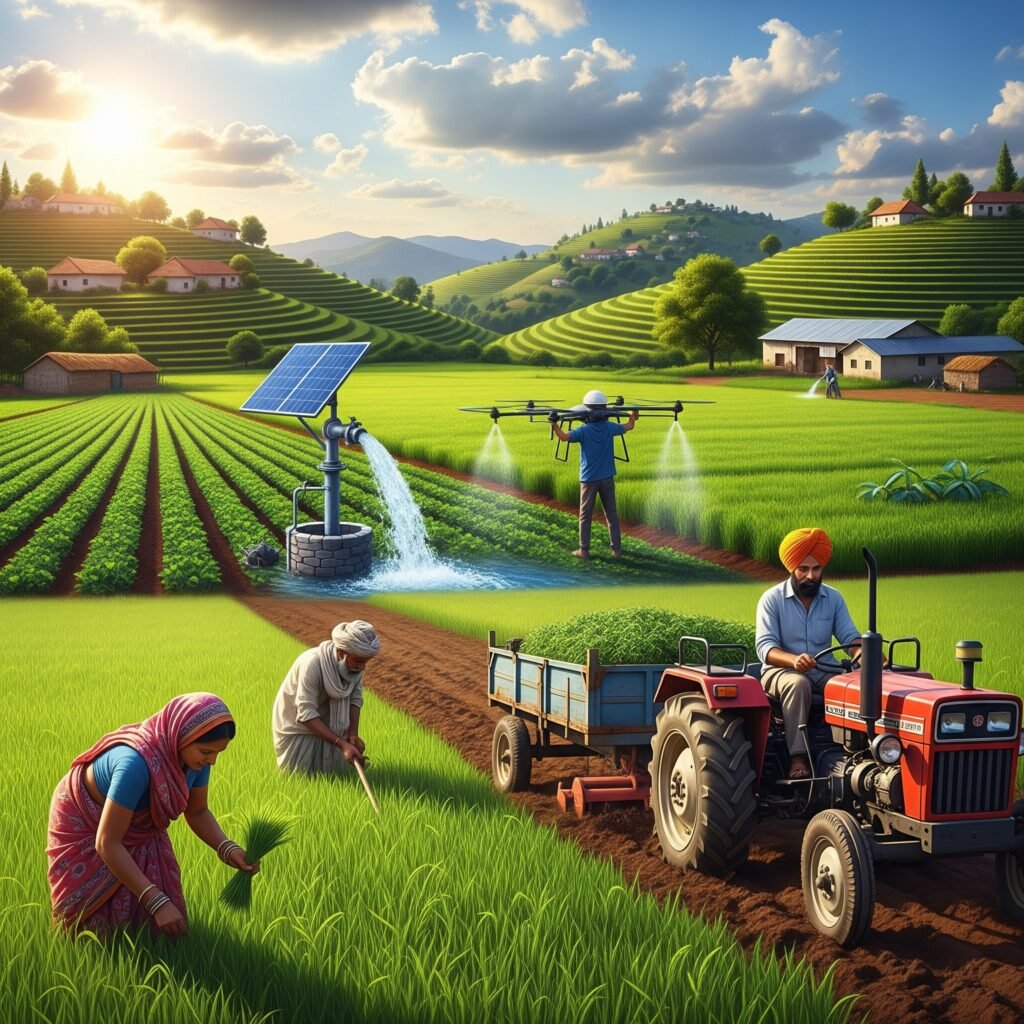Saturday, 22 November 2025

Image Source: AI
After nearly two years of spasmodic negotiations punctuated by political recalibrations, the United Kingdom and India appear to be inching closer to consummating a comprehensive Free Trade Agreement (FTA)—one that could recast the contours of economic engagement between the world’s fifth and sixth largest economies. Yet amidst the sonorous declarations and diplomatic overtures, the more consequential question lurks beneath: Can this FTA transcend tariff tinkering to architect a truly strategic economic partnership?
As of July 2025, the 14th round of discussions has reportedly yielded headway across goods, services, investment protections, and the ever-contentious domain of digital trade. Yet, unsurprisingly, the negotiations remain entangled in thorny issues such as automotive duties, agricultural sensitivities, and the nuanced politics of migration mobility. Notwithstanding leadership transitions in both nations over the past year, the dialogue has found renewed momentum—fueled in part by electoral compulsions in London and post-electoral economic reorientation in New Delhi.
“This trade agreement will lower India’s high tariffs, enhance market access, and provide greater certainty, thereby supporting bilateral trade in goods and services. Import duties on UK exports are estimated to reduce by around £400 million as soon as the FTA comes into force. India Will get huge benefit duty-free access to the UK market for a wide range of agricultural and processed food products. This will boost Indian exports, improve farmer incomes, and potentially increase the competitiveness of Indian agri commodities in the UK “
— Sharmilla Oswal, Board Member, APEDA
This is not just any bilateral deal—it is a strategic pact between two of the world’s top-tier economies poised to retain global prominence for decades. By 2035, the United Kingdom is expected to hold its rank as the sixth-largest economy, while India is projected to surge to third place, reshaping the global economic order. According to the Impact Analysis Report by the UK, with a nominal GDP already exceeding £3 trillion in 2024, India is set on a robust growth trajectory, averaging 5 per cent annually in real terms through 2050.
“The India-UK FTA, aligned with the vision of Viksit Bharat@2047 and powered by the Viksit Krishi Sankalp Abhiyan, is a game-changer for India’s inland fisheries. CIFRI is proud to support this transformation—connecting thousands of fish farmers with global markets, modern technologies, and climate-resilient practices that ensure prosperity from pond to plate ”
— Dr. B. K. Das, Director, ICAR-CIFRI
By mid-century, it is anticipated to house over 250 million high-income consumers—an inflection point that could transform global consumption patterns and position India as a premier growth engine for multinational businesses. Total trade in goods and services between the UK and India was over £40 billion in 2024. India’s demand for global imports is estimated to increase to £2.8 trillion by 2050, making it the third largest importer in the world.
” The India-UK Free Trade Agreement is a significant step for the agricultural economies of both nations, in my perspective. The FTA will grant Indian producers enhanced market opportunities, especially for products like fruits, vegetables, spices, processed foods, and marine products. By removing tariffs, Indian agri-businesses become more price-competitive in the UK’s mainstream and ethnic retail sectors, crucial for expanding the UK Agri-import market.
The pact goes beyond tariffs by addressing technical standards and certification barriers through mutual recognition and streamlined procedures, potentially reducing export rejections and stimulating investment in supply chain modernization.
Crucially, the full benefits of this opportunity can only be realized through inclusive engagement of Farmer Producer Organisations (FPOs). As collective entities representing smallholder farmers, FPOs play an essential role in aggregating produce, enhancing quality compliance, and preparing farmers to meet stringent export standards. Their role in fostering diversification, quality assurance, and scale economies is vital to translating tariff opportunities into sustainable income growth for millions of Indian farmers.
Interestingly, India’s agroclimatic diversity and rich traditional practices offer immense export potential through GI-tagged or region-specific premium products. With a strong network of 30,000+ FPOs, Samunnati will enable select FPOs in key geographic clusters to tap into premium global markets like the UK, supported by Free Trade Agreements, driving decentralised economic growth, employment, and market recognition. Strengthening the FPO ecosystem through targeted capacity building and policy support is therefore central to ensuring that the India-UK FTA drives inclusive, grassroots-led agricultural modernization and rural prosperity ”
— Anil Kumar SG, Founder, Samunnati
Trade Beyond Goods: Unlocking Mobility, Minds, and Markets Across Borders
At its philosophical core, the India–UK Free Trade Agreement is far more than a mundane exercise in tariff arithmetic—it is, in essence, a grand structural reimagining of bilateral commerce, an ambitious endeavour to futureproof economic engagement between two of the world’s most historically intertwined and strategically relevant economies.
” The estimate of India’s rise in agricultural and processed food export is 50 per cent over the next three years. There will be resultant increase in farmers’ incomes, rural prosperity, continued export opportunities and somewhat reduce the rural-urban wealth disparities in India. Tea, mangoes, grapes, spices and condiments, marine products, that is, the so called high value products have been focused upon in CETA. This is hoped to increase the total share of Indian food articles in UK’s import basket, which proportion is low at present “
— Jayanta Kumar Aikat, IASx, Director, Food Processing Industries [Retired], West Bengal
Encompassing 90 per cent of tariff lines and covering 92 per cent of India’s goods imports from the UK (as of 2022), the agreement orchestrates a decade-long calibration of duties that favours gradual liberalisation without abrupt dislocations. The punitive 150 per cent tariff on signature British exports such as Scotch whisky and artisanal gin is to be halved at inception, and progressively tapered to 40 per cent—a nod to both economic pragmatism and consumer aspiration. Equally, British automobile manufacturers—long impeded by protectionist levies reaching an egregious 110 per cent—will, under a calibrated quota regime, gain long-coveted access at a significantly reduced tariff of 10 per cent.

Yet to frame this FTA as merely a litany of tariff reductions would be to miss its transformative essence. It inaugurates a new era of procedural alacrity, with both nations committing to expedited customs clearance—ideally within 48 hours—a salutary boon for just-in-time supply chains and digital-first enterprises. Technical barriers to trade, long a thicket of obfuscation, are to be rationalised, enabling UK manufacturers to navigate Indian regulatory labyrinths with greater ease.
“This India-UK FTA is a game-changer, ushering in a new era of opportunity for Indian agriculture and animal genetics. Duty-free access on over 95 per cent of agricultural and processed food products empowers farmers to reach premium UK markets and contribute to India’s $100 billion agri-export goal by 2030.”
— Prashant Jalan, Founder & Managing Director, Bengal Nestors Industries Limited
In the realm of services—where the United Kingdom continues to hold an unparalleled comparative advantage—the pact guarantees national treatment across a constellation of high-value sectors, including financial services, clean energy solutions, and infrastructure consultancy. Digital commerce, the sine qua non of 21st-century trade, receives due emphasis: interoperability, paperless transactions, and facilitation of cross-border data flows lay the infrastructural bedrock for SME-led exports in the Fourth Industrial Revolution.
“The India–UK FTA is a strategic boost for expanding economy and accelerating agri-tech collaboration, and laying the foundation for sustainable high-value farming partnerships. It’s more than just trade; it signals a modern, forward-looking alliance that champions farmers and fosters innovation ”
— Ravi Hegde, Global Regulatory Lead- Strategy, UPL
Crucially, small and medium-sized enterprises—the lifeblood of both economies—are not relegated to rhetorical footnotes. Dedicated liaison points and trade facilitation channels aim to democratise the gains of globalisation for entrepreneurs beyond the metropolitan elite. The agreement also retains and reinforces Britain’s high thresholds for food safety and animal welfare, assuring the domestic constituency that liberalisation shall not come at the expense of regulatory integrity.
Perhaps most strikingly, the accord treads into territories hitherto uncharted in Indian trade jurisprudence—embedding provisions on gender parity, developmental cooperation, and the transparent conduct of State-Owned Enterprises (SOEs). These are more than ornamental clauses; they signal India’s tentative but tangible foray into values-based trade architecture.
“The India–UK FTA is a welcome move. Our exports to the UK went up by 12.6 per cent last year, and this deal gives us a chance to build on that growth. With regulatory barriers coming down, Indian companies will find it easier to operate in the UK, and that can lead to more affordable services and better collaboration between the two systems. That’s a space worth watching.
At the same time, we can’t lose sight of the fact that FTAs only work well when businesses at home are strong. As more of these agreements are signed, we need to back our local entrepreneurs and MSMEs with the right support—finance, infrastructure, policy clarity. With other FTAs also on the horizon, it’s time to turn inwards as much as outwards. The potential is mind-boggling, so is the need for Indian industry to succeed—not just because of the deal, but with it.”
–– Sanjaya Mariwala, Executive Chairman and Managing Director, OmniActive Health Technologies
Parallel to the FTA, negotiations toward a new Double Contributions Convention (DCC) are underway—a standalone treaty poised to resolve the vexed issue of cross-border double taxation for professionals and businesses. In sum, the India–UK FTA and its accompanying frameworks represent not merely a treaty, but a trade philosophy—one that conjoins market access with regulatory maturity, growth with governance, and economic ambition with moral imagination.
Agricultural Trade: A Delicate Balancing Act
Agriculture remains a cornerstone of contention and opportunity within the FTA framework. India exported nearly $875 million worth of agri-goods to the UK in 2024–25, dominated by rice, marine products, tea, and spices. Conversely, UK exports of agricultural goods to India stood at a modest $125 million, primarily comprising alcoholic beverages, processed foods, and dairy products. Tariff reductions on whisky and cheeses—some of which face Indian duties as high as 150 per cent—have become symbolic flashpoints.

Indian farmer unions have raised flags over the possibility of market disruptions, particularly in dairy and poultry. With UK producers operating at scale and benefiting from EU-aligned subsidies, the asymmetry in competitiveness could trigger both economic and political backlash in rural India. Policymakers are thus treading cautiously, exploring tariff phase-outs, safeguard clauses, and exclusion lists.
The recently ratified Comprehensive Economic and Trade Agreement (CETA) between India and the United Kingdom heralds a consequential realignment in bilateral agricultural commerce, recalibrating the architecture of trade flows in a manner poised to be both strategically beneficial and geopolitically resonant.
In a reciprocal gesture—measured, minimalist, yet diplomatically significant—India has acquiesced to reduce tariffs on a meticulously curated assemblage of British agricultural products. These include cranberries, durians, leeks, artichokes, certain varietals of mushrooms, and lettuce—commodities that, while lacking in domestic volume or rural resonance, are emblematic of the UK’s premium gastronomic repertoire. Their inclusion is unlikely to perturb India’s agrarian equilibrium, instead serving to embellish its urban epicurean landscape and cater to the ascendant appetites of India’s hospitality and gourmet retail sectors.
Crucially, the agreement is underpinned by a prudential safeguarding of India’s agrarian sensitivities. The exclusion of high-volume fruits such as apples, oranges, pineapples, and pomegranates from the concession list signals a strategic circumspection. Likewise, the inviolability of India’s dairy and cereals sectors—enshrined in the exclusion of the entire tariff chapter pertaining to milk, cheese, butter, ghee, and major staples such as rice, wheat, maize, and millets—affirms the government’s commitment to shielding its smallholder farmers from the vicissitudes of unfettered global competition.
The immediate beneficiaries of this recalibrated trade landscape are likely to be Indian producers and exporters of high-growth, value-accretive categories: fresh grapes, onions, natural honey, preserved vegetables and fruits, culinary sauces, and bakery products. For these categories, the dismantling of tariff and non-tariff barriers within the UK offers not merely enhanced market access but a meaningful uplift in global competitiveness.
Yet, beyond the numerical architecture of tariff schedules and product lists lies a more profound ideological shift. CETA’s structure embodies an astute balancing act—an amalgam of calibrated liberalisation with conscious protectionism. It exemplifies India’s capacity to embrace trade integration without imperilling domestic livelihoods, to welcome niche imports without surrendering food sovereignty, and to pursue global relevance while retaining local resilience.
Moreover, the ramifications of this agreement extend well beyond the realm of primary produce. The anticipated increase in export volumes is likely to generate momentum across India’s auxiliary sectors—horticulture, food processing, cold-chain logistics, and agri-tech infrastructure—thereby stimulating a more vertically integrated, traceability-driven value chain that aligns with evolving sustainability mandates.
“The India–UK FTA can open new doors for India’s bamboo industry by enabling tariff-free access to high-value UK markets for bamboo products, from furniture to lifestyle goods. With India’s growing capacity in engineered bamboo and rich traditional crafts, we can position ourselves as a sustainable alternative in the global green materials sector. What’s needed now is targeted support for MSMEs and value chain actors to meet global quality and design standards, and to capitalize on this trade opportunity “
— Kamesh Salam, Bamboo Value Chain Expert
Simultaneously, India’s exporters—especially in organic produce and horticulture—view the FTA as a lever to gain access to the UK’s premium retail market, provided phytosanitary standards and logistics constraints are addressed through regulatory convergence and investment in cold chain infrastructure.
Implications for Agribusiness and Rural Value Chains

The FTA could reshape the landscape of Indian agribusiness in structural ways. On one hand, agro-exporters and food processing firms stand to benefit from improved market access, reduced tariffs, and harmonised standards—particularly in high-margin categories like organic herbs, nutraceuticals, marine products, and ready-to-eat foods.
” The India–UK FTA is not just a trade pact—it’s a bridge connecting the farms of Sangli and the coastlines of Kochi to the premium aisles of British supermarkets. By granting almost duty-free access while protecting our sensitive sectors, it empowers our farmers and fishers to scale up, diversify, and export with confidence. This is a strategic leap for Indian agriculture—unlocking global value for regional produce, from millets and jackfruit to shrimp and spices, and paving the way for an inclusive, export-led rural transformation “
— Dr Suhas Buddhe, CMD, Biocare KMK Pvt. Ltd
On the other hand, it will compel domestic firms to upgrade traceability systems, cold chain capabilities, and compliance with UK food safety laws, prompting a wave of investment in agri-logistics and testing infrastructure. The liberalization of inputs such as agri-machinery, precision farming tools, and post-harvest technologies from UK suppliers may lower costs and boost productivity for Indian farmers, provided access is democratized beyond large agribusinesses.
” The India-UK Free Trade Agreement presents a transformative opportunity for the bamboo industry, unlocking immense potential for sustainable trade and economic growth. As a rapidly renewable resource, bamboo aligns perfectly with global green initiatives, and this FTA can pave the way for enhanced market access, innovation, and collaboration between our nations. By reducing tariffs and streamlining regulations, we can empower Indian artisans and businesses to showcase their eco-friendly bamboo products on a global stage while supporting the UK’s sustainability goals. This agreement isn’t just about commerce—it’s about fostering a greener future together “
— Sanjeev Karpe, Managing Director, Native Konbac Bamboo Products Pvt. Ltd
However, concerns remain over the influx of subsidised UK dairy and processed food items, which could squeeze margins for India’s fragmented and informal rural producers. A carefully sequenced liberalisation roadmap—anchored in rural R&D, cooperative scale-ups, and agritech integration—will determine whether this FTA catalyses or cannibalises India’s agribusiness ambitions.
A Realignment of Global Trade Partnerships
From a geopolitical standpoint, CETA is a trade alignment born of mutual necessity. Britain, since its exit from the European Union, has struggled to redefine its trade corridors beyond Europe. For India, long wary of asymmetric FTAs, this deal provides a template for high-ambition, high-balance trade diplomacy. It is telling that India held its line on sensitive sectors such as dairy, automobiles, and agriculture—areas where premature liberalisation could expose vulnerable domestic producers. The result is a rare hybrid: a free trade agreement that combines commercial boldness with political prudence.
” The India–UK Free Trade Agreement (FTA), signed on 24 July 2025, marks a significant milestone for India’s seafood industry. The agreement grants zero-duty access to nearly 99 per cent of Indian seafood products entering the UK market, eliminating tariffs that previously reached up to 21.5 per cent. Key export categories benefiting from this move include Vannamei and black tiger shrimp, frozen squid, pomfret, tuna, fishmeal, and a range of value-added seafood products. The only exception is fish sausages, which remain outside the duty-free ambit.
Industry experts anticipate a major export boom following the tariff elimination, with forecasts projecting up to a 70 per cent surge in Indian seafood exports to the UK in the coming years. Some estimates suggest that export volumes could potentially double, significantly increasing India’s current market share of 2.25 per cent in the UK’s $5.4 billion seafood import market.
Coastal states such as Andhra Pradesh, Gujarat, and Odisha, known for their robust seafood production ecosystems, are poised to gain the most from this trade liberalization. The FTA also places Indian exporters on equal footing with competitors from Vietnam and Singapore, who already enjoy preferential access under their own agreements with the UK.
Beyond trade gains, the deal supports India’s broader strategic goals of enhancing marine exports and advancing the blue economy, positioning the country as a leading global supplier of sustainable seafood”
— Dr. Bimal Kinkar Chand, Joint Director of Research, West Bengal University of Animal & Fishery Sciences
But trade agreements, even the best-drafted ones, succeed only in their execution. India’s capacity to translate this opening into real economic value will depend on how quickly its MSMEs, state governments, export clusters, and customs ecosystems adapt. The challenge is no longer market access—it is market readiness. Regulatory compliance, especially with respect to UK standards on environmental safety, packaging, and labour norms, will demand investment in quality infrastructure and exporter awareness. Without this, the tariff advantage risks becoming academic.
Toward a New Playbook for India’s Globalisation
This agreement is more than a bilateral trade deal; it is a bellwether for how India will engage with a rapidly fragmenting global economy. With talks ongoing with the EU, EFTA, and Canada, the UK deal may become a blueprint—codifying India’s pivot from defensive liberalisation to strategic, high-ambition tradecraft. If these negotiations mirror even a fraction of CETA’s structural coherence, India’s trade doctrine for the 2030s will transform from reactive to visionary.
CETA signals a maturing of India’s trade mindset. No longer confined to tariff gymnastics, the country is embracing the contours of modern trade—anchored in legal interoperability, supply chain resilience, and labour mobility. Perhaps most pivotally, it allows India’s greatest strength—its human capital—to flourish globally, unencumbered by antiquated visa regimes or punitive tax structures.
In sum, the India–UK CETA is not merely a transactional accord; it is a testament to the maturing of India’s trade diplomacy. By combining economic pragmatism with strategic foresight, the agreement carves out a nuanced yet bold path—one that seeks to transmute India’s agricultural abundance into export excellence and transform farmgate prosperity into global market positioning. In essence, this is not just a free trade agreement—it is a foundational handshake for the next chapter of globalisation. One where trust, talent, and technology flow across borders with unprecedented symmetry. For India and the UK, it is a pact not just of commerce, but of convergence.
——————– Suchetana Choudhury (suchetana.choudhuri@agrospectrumindia.com)